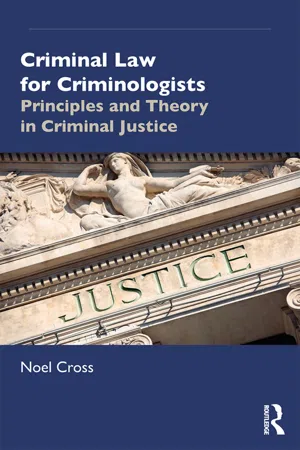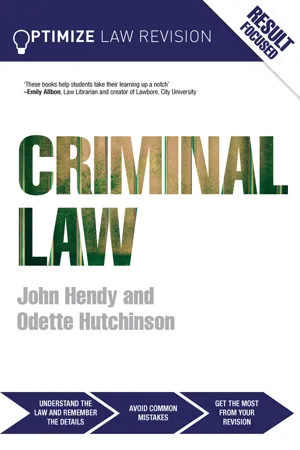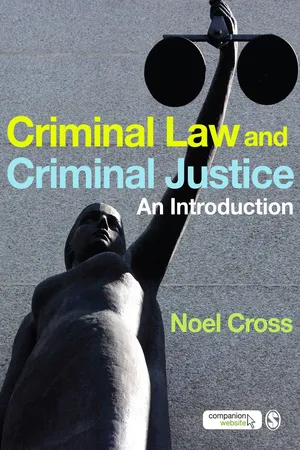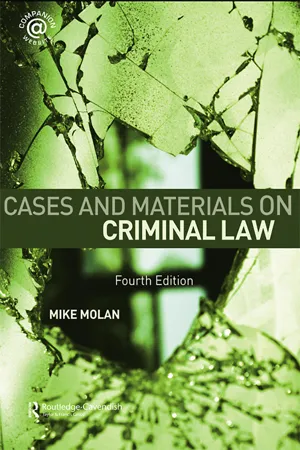Law
Non-fatal Offences
Non-fatal offences refer to criminal acts that result in harm or injury to the victim but do not cause death. These offences include assault, battery, and grievous bodily harm. Non-fatal offences are typically categorized based on the severity of the harm caused and are prosecuted under criminal law. Penalties for these offences vary depending on the specific circumstances and jurisdiction.
Written by Perlego with AI-assistance
Related key terms
8 Key excerpts on "Non-fatal Offences"
- eBook - ePub
Criminal Law for Criminologists
Principles and Theory in Criminal Justice
- Noel Cross(Author)
- 2020(Publication Date)
- Routledge(Publisher)
Chapter 6Non-fatal assaultsChapter overviewIntroduction Non-fatal assaults: the law Common assault Battery Racially and religiously aggravated assault Harassment and stalking offences Assault occasioning actual bodily harm Wounding, and inflicting grievous bodily harm Wounding or causing grievous bodily harm with intent Consent as a defence to non-fatal assaults Non-fatal assaults and criminal justice Non-fatal assaults, the police, and the CPS Non-fatal assaults, the court process, and punishment Conclusions: linking discussion to the roadmap theories Further readingChapter aimsAfter reading Chapter 6 , you should be able to understand:• Which non-fatal, non-sexual assault offences are in criminal law• What the actus reus and mens rea requirements are for each offence• How the criminal offences designed to deal with harassment and stalking work• What the consent defence is in the context of assault, and how it works• How criminal justice, in terms of the police, CPS, courts, and punishment agencies respond to non-fatal assaults• How the evidence on non-fatal assaults in criminal law and criminal justice fits in with the theoretical models introduced in Chapter 1IntroductionThis chapter discusses non-fatal, non-sexual offences against the person – offences of assault, which do not result in death. The first part of this chapter explains the law on non-fatal assaults in detail, examining its basis in the Offences against the Person Act 1861 (referred to as ‘OAPA’ hereafter in this chapter). The second part of the chapter then contextualises the law by examining how it is used in criminal justice practice, and how the roadmap models in Chapter 1 - eBook - ePub
Modern Criminal Law
Fifth Edition
- Mike Molan(Author)
- 2013(Publication Date)
- Routledge-Cavendish(Publisher)
CHAPTER 7Non-fatal Offences AGAINST THE PERSON
7.1 INTRODUCTION
In criminal law, the term ‘Non-fatal Offences against the person’ encompasses what might be called the ‘mainstream’ Non-fatal Offences against the person, such as causing grievous bodily harm, malicious wounding, actual bodily harm, assault and battery, ancillary offences such as poisoning, harassment and racially motivated offences, and sexual offences such as rape, indecent assault and various other forms of unlawful sexual conduct. It has long been acknowledged that this area of the criminal law is in need of urgent reform. The main statutory provision regarding assault-related offences is the Offences Against the Person Act (OAPA) 1861, which itself was largely a consolidating provision bringing together even earlier enactments in one piece of legislation. As will be seen there has been no shortage of law reform proposals, but for the moment it seems that only sexual offences are likely to be the subject of any significant statutory restatement in the near future (see below, 7.13 ).7.2 COMMON ASSAULT AND BATTERY
Assault and battery existed as common law offences for centuries and, as will be seen, involve concepts that have been incorporated into more serious statutory offences such as assault occasioning actual bodily harm (s 47 of the OAPA 1861), assault upon a police officer (s 89 of the Police Act 1996) and indecent assault (ss 14 and 15 of the Sexual Offences Act (SOA) 1956).7.2.1 Actus reus of common assault
The actus reus of assault, where the term assault is used in its narrow technical sense, merely requires proof that D has caused P to apprehend that immediate and unlawful violence is about to be inflicted upon him. Much confusion is caused by the fact that parliament, judges, lawyers and academics use the term assault in two senses. The narrow sense, as just described, but also in the broad sense to imply that there has also been some physical contact. Lord Lane CJ in Mansfield Justices ex p Sharkey - eBook - ePub
- John Hendy, Odette Hutchinson(Authors)
- 2015(Publication Date)
- Routledge(Publisher)
3Non-fatal Offences Against the PersonUnderstand the law • Can you define each of the offences in this chapter?• Which offences in this chapter are common law offences, and which are statutory offences outlined in the OAPA 1861 ?Remember the details • Can you remember the actus reus and mens rea of each offence?• Can you define each element of the actus reus and mens rea using case law examples?Reflect critically on areas of debate • Do you understand how consent may operate as a defence to an offence in this chapter?• Can you define intention and recklessness accurately and critically discuss them in relation to case law examples?Contextualise • Can you relate these offences to other areas of criminal law such as sexual offences and homicide?Apply your skills and knowledge • Can you complete the example essay and problem questions provided in each section of this chapter using case law and statutes to support your answer?Chapter Map
Elements Chart
Introduction
In this chapter we are going to consider Non-fatal Offences against the person. This is a popular examination topic in its own right, but issues in relation to Non-fatal Offences against the person can overlap with sexual offences, property offences and homicide against the person. This is another area of the criminal law syllabus in which is it vitally important that you have a solid understanding of because this area of law may be related to a significant proportion of your studies.Aim HigherAs you progress through this chapter, think about how these Non-fatal Offences relate to other criminal offences, such as homicide, sexual offences or property offences. This will help your understanding of these and other offences, and how they interact.In this chapter we will start by considering the least serious offences against the person and at the end we will consider the most serious offences against the person. A traditional classification for Non-fatal Offences against the person is to classify them as ‘simple offences’ and ‘aggravated offences’. - eBook - ePub
Criminal Law & Criminal Justice
An Introduction
- Noel Cross(Author)
- 2009(Publication Date)
- SAGE Publications Ltd(Publisher)
Chapter 1Introduction
Chapter 6 is the first of the chapters in the book which explain the major types of specific criminal offence. This chapter covers non-fatal, non-sexual assaults against the person.1 The first part of this chapter explains the law on non-fatal assaults in detail. The second part of the chapter then contextualises the law by examining how it is used in criminal justice practice.Non-Fatal Assaults: The Law
Making sense of non-fatal assaults
DEFINITION BOX 6.1 NON-FATAL, NON-SEXUAL VIOLENT OFFENCES Criminal offences which involve some kind of physical or psychological harm being caused to V by D, which does not involve sexual activity.The law on Non-fatal Offences against the person deals with situations where the criminal law prohibits contact with, and sometimes injury of, another person’s body. The law is based around statutory definitions of different types of assault, contained in the Offences against the Person Act 1861 (hereafter ‘OAPA’). The different categories of assault will now be discussed, starting with the least serious offences and moving towards the most serious. A defence to non-fatal assaults – consent – will then be explained.Common assault
Actus reus
Common assault is now defined as a criminal offence in s. 39 of the Criminal Justice Act 1988, although the common law offence is still in operation (DPP v Taylor; Little [1992] 1 All ER 299). The actus reus is the same for both the statutory and the common law offences. D must cause V to ‘apprehend immediate application of unlawful violence to the body’ (Venna [1976] QB 421). V must fear that they will suffer unlawful violence in the immediate future, rather than at some other later time (Tuberville v Savage (1669) 1 Mod Rep 3). There is no need for the violence to actually occur, as long as V feels that they are about to suffer such violence against them. Under Logdon v DPP [1976] Crim LR 121, as long as V is in fear, it does not matter if the violence is not actually possible in the circumstances. Conversely, if V does not fear unlawful violence, then the actus reus of assault has not been committed, even if V actually does suffer unlawful violence which has been caused by D (Lamb [1967] 2 QB 981). Fagan v Metropolitan Police Commissioner [1969] 1 QB 438 shows that assault can be committed by D’s omissions as well as acts. Ireland; Burstow - eBook - ePub
Cases & Materials on Criminal Law
Fourth Edition
- Mike Molan(Author)
- 2009(Publication Date)
- Routledge-Cavendish(Publisher)
Chapter 5 Non-fatal Offences Against the PersonDOI: 10.4324/9780203885833-5Contents
- 5.1 Introduction
- 5.2 Section 18 Offences Against the Person Act 1861 – Wounding or Grievous Bodily Harm with Intent
- 5.3 Section 20 Offences Against the Person Act 1861 – Malicious Wounding or Grievous Bodily Harm
- 5.4 Section 47 Offences Against the Person Act 1861 – Assault Occasioning Actual Bodily Harm
- 5.5 Poisoning
- 5.6 Common Assault and Battery
- 5.7 ‘Stalking'
- 5.8 Racially Motivated Assaults and Harassment
- 5.9 Codification and Law Reform Proposals
- 5.10 Consent to Physical Harm as a Defence
5.1 Introduction
The material selected for this chapter aims to cover the mainstream Non-fatal Offences against the person, as well as the related issue of consent to harm. Sexual offences are considered in Chapter 6 . The law relating to Non-fatal Offences against the person is to be found in a hotchpotch of common law and statutory provisions. It is an area crying out for reform and rationalisation. Despite the existence of workable proposals for codification, there is little sign of any government having the desire to take the political initiative.The major offences are:- s 18 Offences Against the Person Act 1861 – wounding or grievous bodily harm with intent;
- s 20 Offences Against the Person Act 1861 – malicious wounding or grievous bodily harm;
- s 47 Offences Against the Person Act 1861 – assault occasioning actual bodily harm;
- common assault; and
- common battery.
In addition there are offences of poisoning, harassment, and racially aggravated forms of assault. The prosecution may also seek to rely on public order offences such as affray and riot – see ss 1 to 5 of the Public Order Act 1985 as amended. - eBook - ePub
- Andrew Mitchell(Author)
- 2008(Publication Date)
- Routledge-Cavendish(Publisher)
apply the law, first and foremost, so do not rely solely on the indicative JCS when answering problem questions in this area.IT’S A FACT!
12.1: The Non-fatal OffencesAccording to The Daily Telegraph (6/2/07), the UK was listed by the European Crime and Safety Survey as the European country with most ‘assaults’ (a word to be read here in the loosest sense as crimes of non-fatal violence) occurring, according to the experiences of respondents to the survey. This evidence tends to support rises in the commission of Non-fatal Offences that the Government’s own studies have reported. The Times had earlier commented (on 22/4/05) that crime patterns in general since 1960 indicated a significant rise in non-fatal crimes of violence, in particular wounding and acts endangering life, and common assault (loosely referring to assault and battery).Please note also that the following coverage of assault and battery examines these separate offences, though they are both occasionally referred to as ‘common assault’.Assault
The actus reus of assault is an act that places another person in fear of immediate and unlawful violence. This can be committed by: acts alone (such as raising fists, or brandishing a replica gun); acts and words (such as raising fists and using threatening language); by threatening words alone; or even, in certain circumstances, by silence. In R v Ireland (1996), the defendant made a series of silent phone calls at night to three women who all subsequently suffered psychiatric illness. This was seen as an assault. Occasionally, however, the precise words used by the defendant might also have the effect of undermining an assault. For example, in Tuberville v Savage - eBook - ePub
- Jacqueline Martin, Tony Storey, Natalie Wortley(Authors)
- 2022(Publication Date)
- Routledge(Publisher)
7Non-fatal Offences against the personDOI: 10.4324/9781003326793-7AIMS AND OBJECTIVES
After reading this chapter you should be able to:- Understand the actus reus and mens rea of common assault
- Understand the actus reus and mens rea of assault occasioning actual bodily harm (s 47)
- Understand the actus reus and mens rea of malicious wounding/inflicting grievous bodily harm (s 20)
- Understand the actus reus and mens rea of wounding or causing grievous bodily harm with intent (s 18)
- Understand the actus reus and mens rea of strangulation and suffocation
- Understand the circumstances in which a person will be charged with racially or religiously aggravated assault
- Analyse critically the law on Non-fatal Offences against the person
- Apply the law to factual situations to determine whether there is liability for Non-fatal Offences against the person
The main offences are set out in the Offences Against the Person Act 1861 (OAPA). This Act merely tidied up the then existing law by consolidating all of the offences in one Act. It did not create a coherent set of offences and, as a result, there have been many problems in the law and many proposals for reform. In 1980 the Criminal Law Revision Committee made recommendations in its 14th Report, Offences Against the Person (Cmnd 7844, 1980). The Law Commission adopted these ideas, first in its Draft Criminal Code (1989) and then in 1993 in its report Legislating the Criminal Code: Offences Against the Person and General Principles. In February 1998 the Home Office issued a Consultation Document, Violence: Reforming the Offences Against the Person Act 1861, which pointed out that the 1861 Act ‘was itself not a coherent statement of the law but a consolidation of much older law. It is therefore not surprising that the law has been widely criticised as archaic and unclear and that it is now in urgent need of reform.’ The consultation document included a draft Bill (see section 7.7 ). Most recently, the Law Commission published Reform of Offences Against the Person(Law Com No 361) in November 2015. This Report recommended enactment of the Home Office’s 1998 draft Bill, with some modifications. Despite all of this, Parliament as yet has not reformed the OAPA. However, in 2021, Parliament did enact the Domestic Abuse Act 2021 which reformed this area of law by creating two new offences: strangulation and suffocation (see section 7.9 - eBook - ePub
- Chloë Kennedy, Lindsay Farmer, Chloë Kennedy, Lindsay Farmer(Authors)
- 2023(Publication Date)
- Routledge(Publisher)
I first encountered Jeremy Horder’s ‘Rethinking Non-fatal Offences Against the Person’ as a first-year undergraduate student at the University of Oxford during, incidentally, Horder’s final year there, before he took up the Edmund Davies Professorship at Kings College, London. I cannot pretend to recall my first impressions of the paper. I have a far clearer recollection of revisiting it when I began teaching criminal law, as a doctoral student, some six years later. By this point, Horder had moved on to the London School of Economics, where he remains a Professor of Criminal Law and, as ‘Rethinking Non-fatal Offences Against the Person’ was (to my recollection) still a mainstay of the undergraduate criminal law reading list, I approached the argument with my students in mind. I hoped they would find the paper a thought-provoking engagement with the principle of fair labelling, and that it might help them to develop a more sophisticated understanding of the principle than necessarily cursory textbook discussions allow. It also served an occasional secondary function: as an example, to students, of how much more intellectually rewarding it can be to challenge the underlying assumptions upon which Law Commission proposals are based, rather than to adopt them, uncritically, as the solution to the problem of the week.In ‘Rethinking Non-fatal Offences Against the Person’, Horder takes aim at the Law Commission’s 1993 proposals1 for reforming Non-fatal Offences.2 He castigates the ‘moral vacuity’3 of the three main offences proposed by the Commission, which variously centre upon intentionally causing serious injury, recklessly causing serious injury, or causing injury either recklessly or intentionally.4 Horder, drawing inspiration from the code of King Alfred,5 seeks to find a middle ground between the historic tendency towards over-particularity and the bland, overgeneralisations found in the Law Commission’s work. Advocating for ‘moral nominalism’ and ‘representative labelling’, he calls for of-fence definitions to capture ‘the moral essence of the wrong in question, by reference to the best moral conception of that essence in society as it is today’.6 The result is a proposed series of five offences, centred around specific wrongs. These wrongs not only focus on intentionality and some general conception of harm but, crucially, the way in which the harmful outcome is brought about – the mode of responsibility, which in turn results in greater specificity in the identification and ranking of various harms.*
Learn about this page
Index pages curate the most relevant extracts from our library of academic textbooks. They’ve been created using an in-house natural language model (NLM), each adding context and meaning to key research topics.







